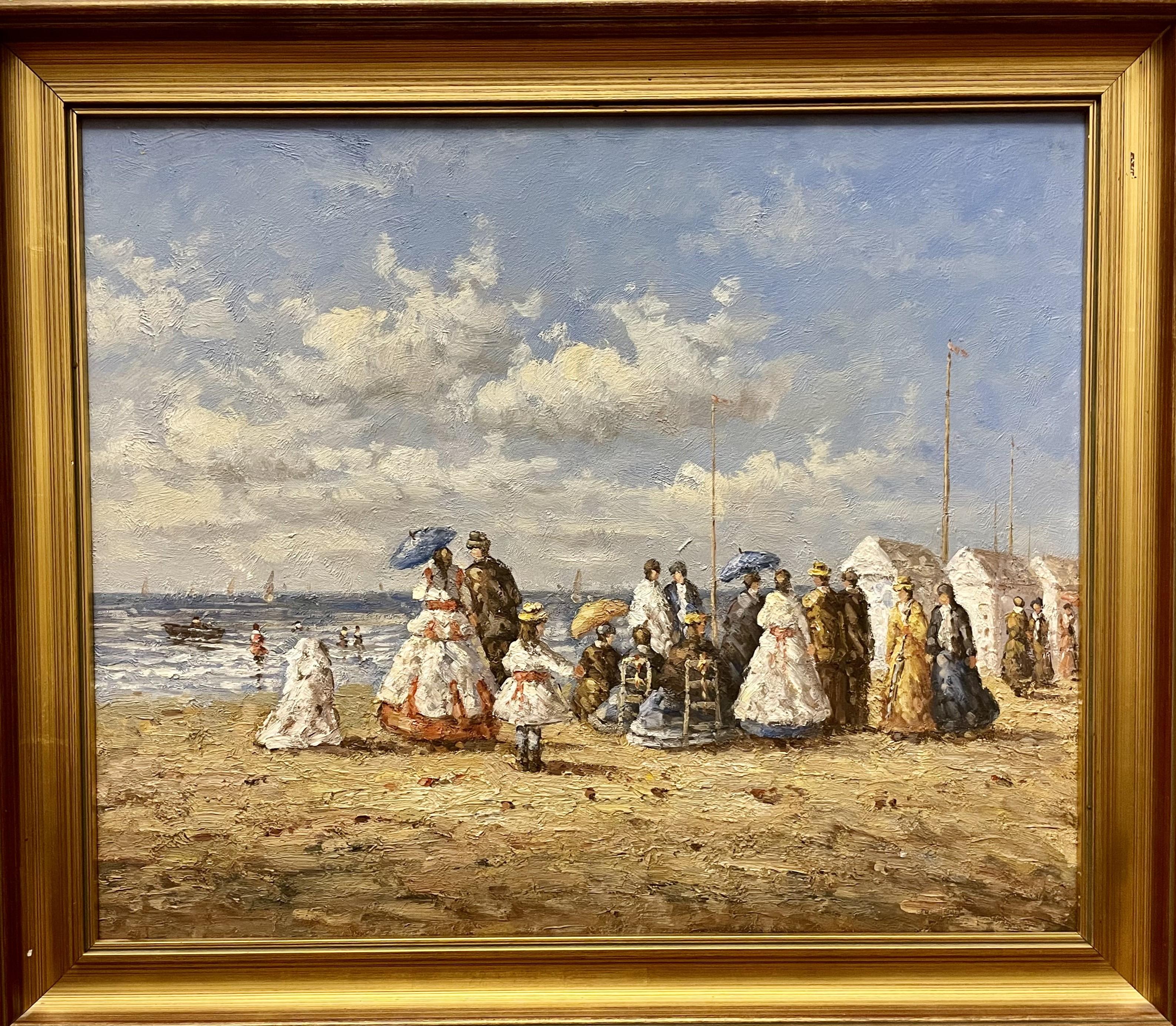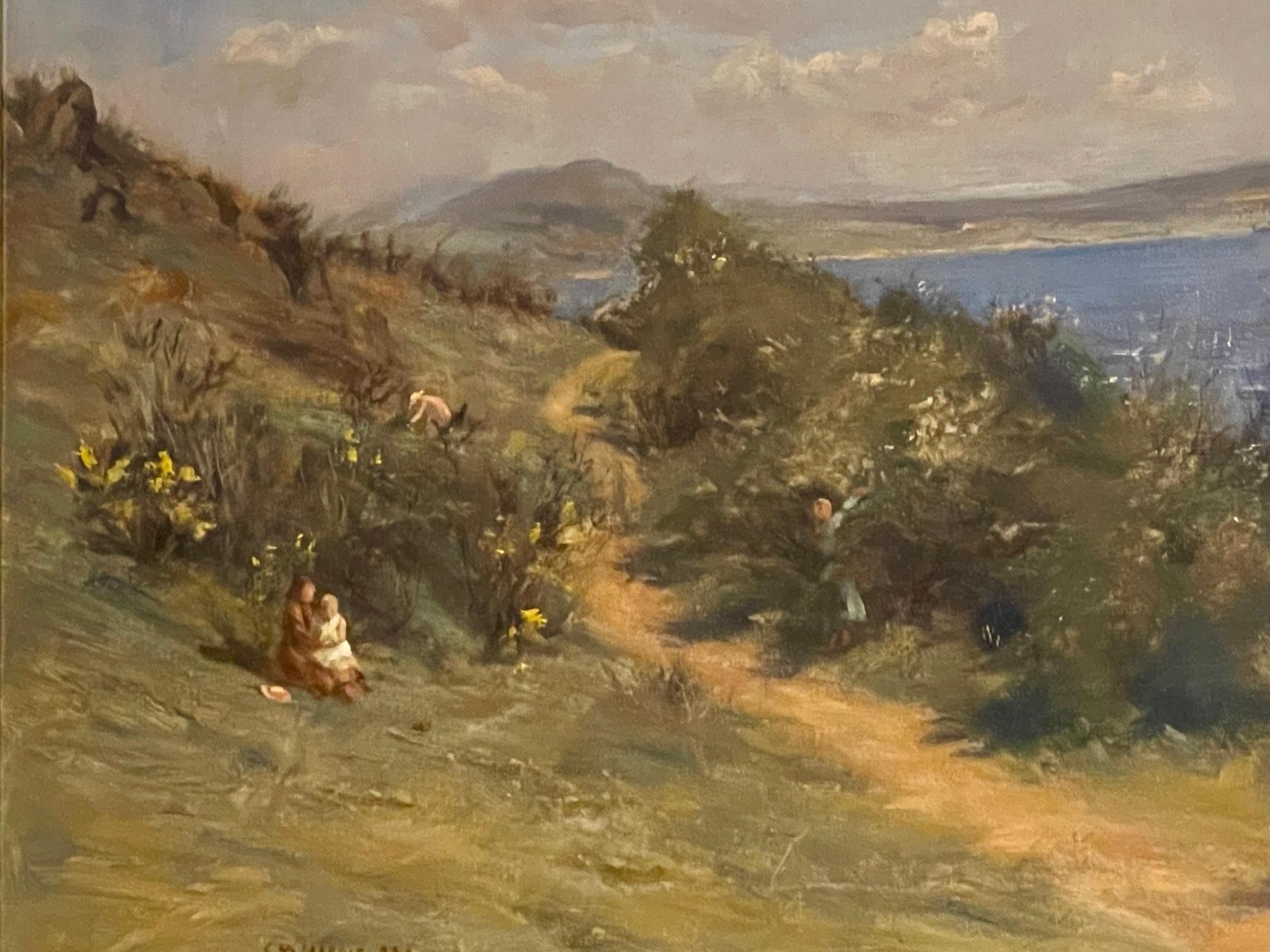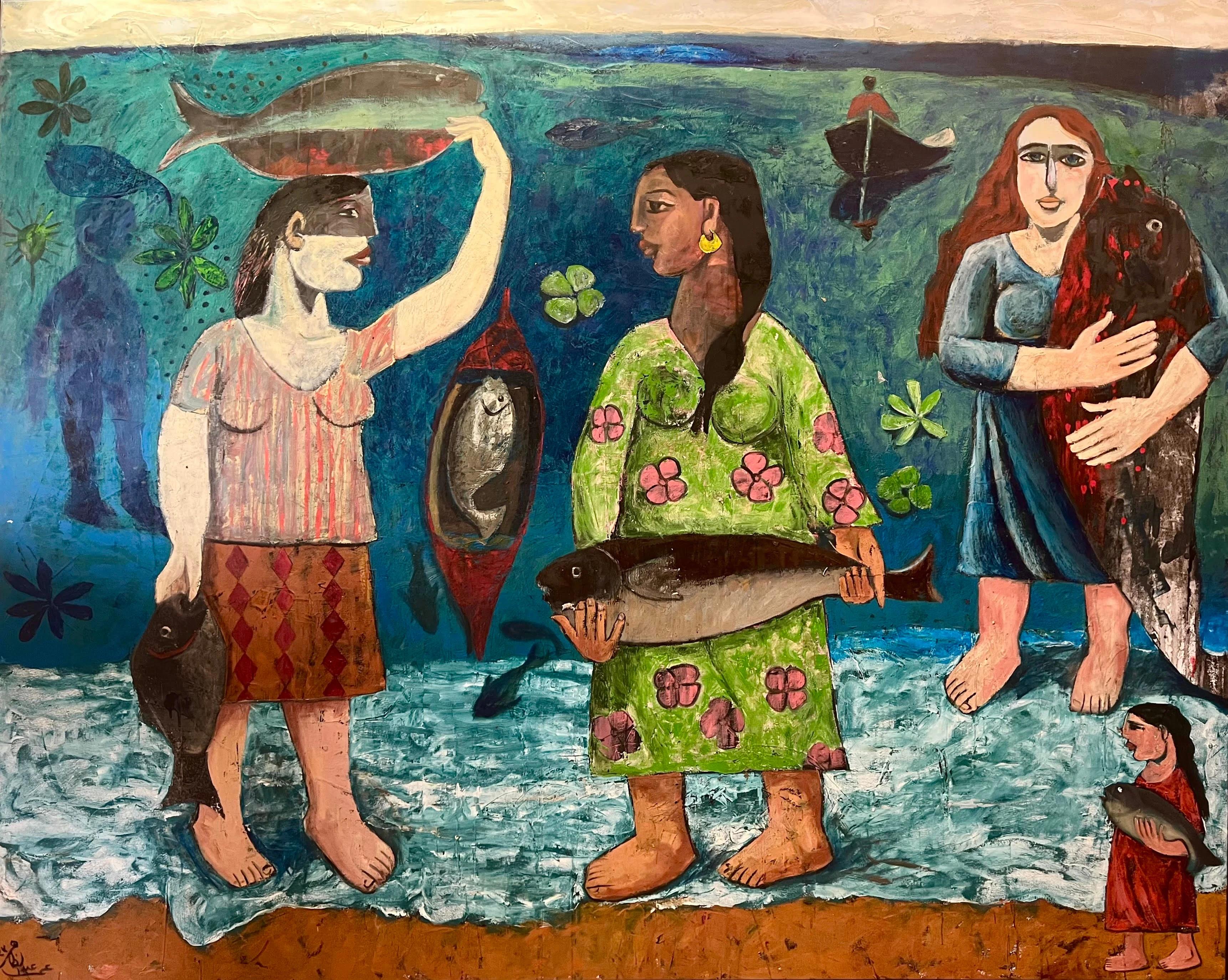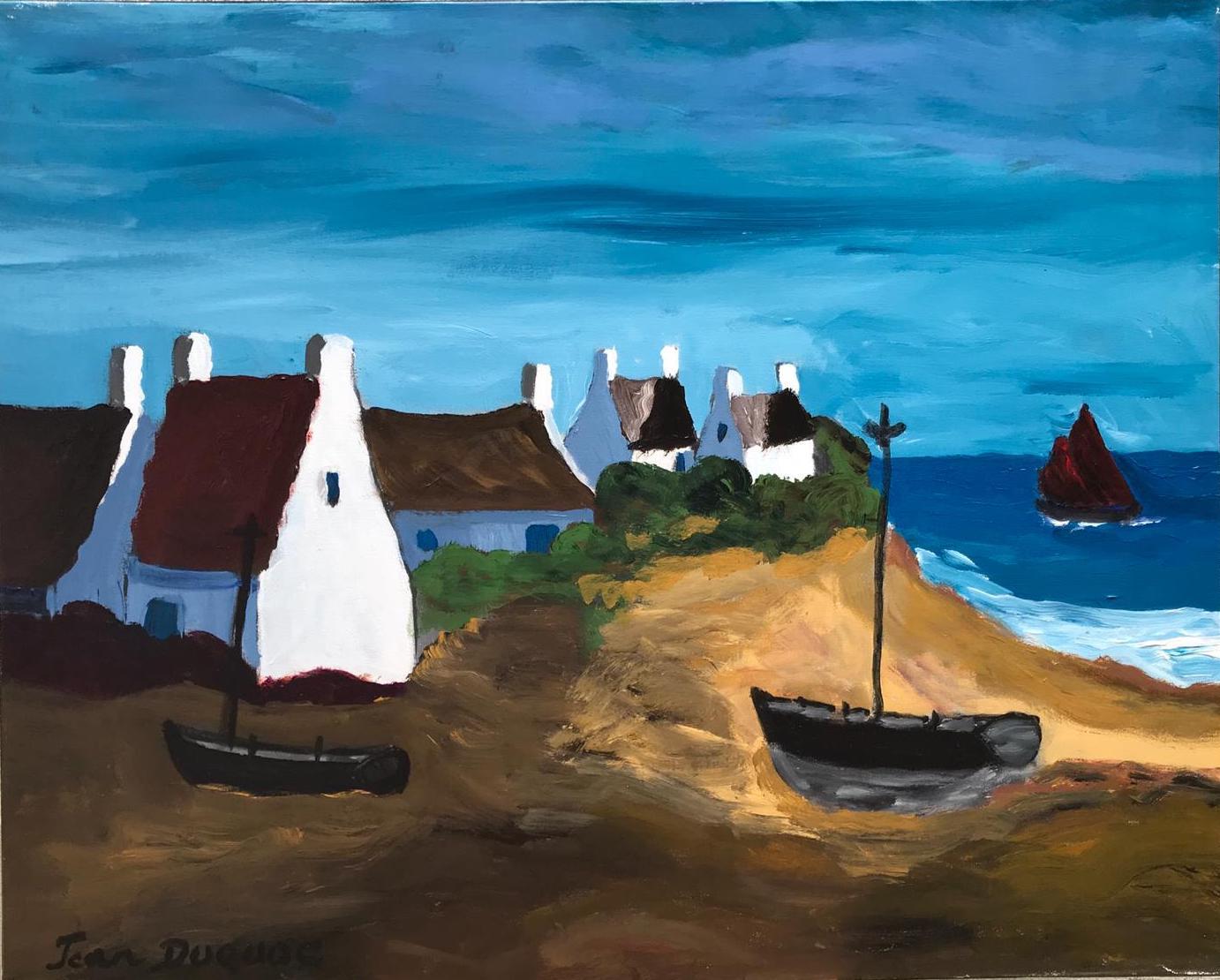Items Similar to Late Summer River Landscape / - Realistic Impression -
Video Loading
Want more images or videos?
Request additional images or videos from the seller
1 of 11
Jan Hillebrand WijsmüllerLate Summer River Landscape / - Realistic Impression -c. 1900
c. 1900
About the Item
Jan Hillebrand Wijsmuller (1855 Amsterdam - 1925 ibid.), Late Summer River Landscape, oil on canvas, relined, 34 x 56 cm (inside measurement), 43 x 64 cm (frame), signed J[an] H[illebrand] Wijsmuller at lower right.
- in good condition, the frame with isolated bumped spots
- Realistic Impression -
About the artwork
The panoramic landscape format shows a river landscape, with the course of the river, which curves to the right, leading the eye into the depths of the picture and tempting it to continue the landscape in the imagination beyond the visible area. At the same time, however, the fact that the landscape is not visible through the bend in the river focuses our gaze on the entirety of the landscape depicted, without prompting us to focus on distant details. Accordingly, the brushstroke is not designed to render details with realistic precision. In the front left area of the river there is even a completely free brushwork, trained by Impressionism, which nevertheless remains committed to representational and convincingly suggests the movement of the water.
Regardless of the distance of the observer, the entire picture is painted with the same broad brushstroke, so that the landscape is given as an impression. And yet this impression is not ephemeral, as in the case of French Impressionism, to put it exaggeratedly, but reveals to us the essence of the landscape in all its richness. This is why the Dutch variant of Impressionism is always also a realism, although the pictures appear less progressive, but still contain a dimension of landscape painting that is lost with progress.
In the impression, the reality of the landscape is revealed, and this happens as we experience the landscape in the visual impression. Wijsmuller does not depict houses or people in order to allow the experience of the landscape to fully unfold. The experience is determined first and foremost by the river, which does not flow into the picture from our point of view, but towards us. Where the river begins to bend, the water is churned by a rapids. Toward us, the riverbed widens and the water comes to rest, covering the entire width of the foreground like a mirror.
The stillness of the water corresponds to the evening mood of the late summer landscape, in which the warm tones of the evening light blend with the yellow and brown tones of the plants. A gentle, almost idyllic reality, carried by the brushstroke, yet animated by a liveliness that is also made visible by the brushstroke. The broad, dynamically placed brushstrokes evoke the movement of the treetops and animate even the immobile reeds, while the trunks on the right bank, executed in virtuoso white strokes that seem like markings, make the sunlight shine. On the other bank, a carpet of light also spreads out, its energetic effect again expressed in the brushstroke. The dynamic of the landscape is further enhanced by the complementary color contrasts between the greens, yellows, and browns on the one hand and the blue of the all-encompassing sky on the other. A contrast that is intensified by the reflection in the water.
The evening coming to rest of the landscape is thus at the same time an all-encompassing contrasting and yet in itself harmonious movement. This reality becomes accessible to us as an experience in the impression of the landscape.
About the artist
Jan Hillebrand Wijsmuller entered the Royal Academy of Arts in Amsterdam in 1876 and studied under the innovative Professor August Allebé, who was famous for the Amsterdam Impressionism, also known as the Allebé School.
In 1877, Wijsmuller transferred to the Hague Academy of Art, and thus to the Hague School, and then completed his studies at the Brussels Academy of Art. Returning to the Netherlands, Wijsmuller opened his own studio in Amsterdam.
In 1883 he won the prestigious Young Artist Award, donated by Willink van Collen, which made Wijsmuller a well-known and sought-after artist.
Wijsmuller was a member of the Societät Arti et Amicitiae Amsterdam and the Pulchri Studio in The Hague.
Wijsmuller belongs to the second generation of the Hague School. While Vincent van Gogh described the protagonists of the first generation to his brother Theo as "the great gray people," the second generation, and Wijsmuller in particular, used a much more colorful palette. His oeuvre makes him a major player in Dutch Impressionism, the second Golden Age of Dutch painting.
Selection of public collections that own paintings by Jan Hillebrand Wijsmuller:
Historisches Museum, Amsterdam / Rijksmuseum, Amsterdam / Stedelijk Museum, Amsterdam / Museum Willet-Holthuysen, Amsterdam / Dordrechts Museum, Dordrecht / Dienst Verspreide Rijkscollecties, Den Haag / Gemeentemuseum, Den Haag / Museum Mesdag, Den Haag / Stadhuis, Den Haag / Goois Museum, Hilversum / Zeeuws Museum, Middelburg / St. Vrienden Museum Noordwijk, Noordwijk / Belasting & Douane Museum, Rotterdam
GERMAN VERSION
Jan Hillebrand Wijsmuller (1855 Amsterdam - 1925 ebd.), Spätsommerliche Flusslandschaft, Öl auf Leinwand, doubliert, 34 x 56 cm (Innenmaß), 43 x 64 cm (Rahmen), rechts unten mit „J[an] H[illebrand] Wijsmuller“ signiert.
- in gutem Zustand, der Rahmen mit vereinzelten bestoßenen Stellen
Exposé als PDF
- Realistische Impression -
zum Kunstwerk
Das panoramaartige Querformat zeigt eine Flusslandschaft, wobei der nach rechts geschwungene Flusslauf den Blick in die Tiefe des Bildes hineinführt und dazu verleitet, die Landschaft in der Vorstellung über den sichtbaren Bereich hinaus fortzusetzen. Dass sich die Landschaft durch die Biegung des Flusses entzieht, konzentriert unseren Blick aber zugleich auf den präsentierten Landschaftsausschnitt im Ganzen, ohne dazu angespornt zu werden, entfernte Details fokussieren zu wollen. Dementsprechend ist auch der Pinselduktus nicht darauf angelegt, Details in einer realistischen Präzision zu gewahren. Im linken vorderen Bereich des Flusses ist gar eine ganz freie, vom Impressionismus geschulte Pinselführung zu gewahren, die dennoch dem Gegenständlichen verpflichtet bleibt und überzeugend die Bewegung des Wassers suggeriert.
Unabhängig von der dargestellten Entfernung des Betrachters ist das ganze Bild in demselben breiten Pinselduktus gehalten, wodurch die Landschaft als ein Eindruck, also als Impression gegeben ist. Und doch ist die Impression nichts Ephemeres, wie dies – überspitzt formuliert – im französischen Impressionismus der Fall ist, sie erschließt uns in ihrer Reichhaltigkeit das Wesen der Landschaft. Daher ist die niederländische Variante des Impressionismus immer zugleich auch ein Realismus, wodurch die Bilder freilich weniger progressiv erscheinen, dafür aber weiterhin eine Dimension der Landschaftsmalerei enthalten, die mit der Progression verloren geht.
In der Impression wird die Realität der Landschaft offenbar und dies geschieht, indem wir im Seheindruck die Landschaft erleben. Um das Landschaftserlebnis zur vollen Wirkung kommen zu lassen, stellt Wijsmuller keinerlei Häuser oder Menschen dar. Zunächst wird das Erlebnis vom Fluss bestimmt, der nicht – unserer Blickrichtung entsprechend – ins Bild hinein, sondern auf uns zu fließt. Dort, wo die Krümmung des Flusses einsetzt, ist das Wasser durch eine Stromschnelle aufgewühlt. Zu uns hin weitet sich das Flussbett und das Wasser kommt zur Ruhe, so dass es wie ein Spiegel die ganze Breite des Bildvordergrundes durchmisst.
Das Zur-Ruhe-Kommen des Wassers entspricht der Abendstimmung der spätsommerlichen Landschaft, in der sich das warmtonale Abendlicht mit den Gelb- und Brauntönen der Pflanzen vermählt. Eine vom Pinselduktus mitgetragene sanfte, beinahe idyllische Realität, die dennoch von einer ebenfalls durch den Pinselduktus sichtbar gemachten Lebendigkeit beseelt ist. Die breiten dynamisch gesetzten Pinselstriche evozieren eine Bewegtheit der Baumkronen und vitalisieren auch das unbewegte Schilf, während die in weißen virtuosen Strichlagen ausgeführten, wie Markierungen wirkenden Stämme am rechten Ufer das Sonnenlicht zum Aufleuchten bringen. Auf der anderen Uferseite breitet sich ebenfalls ein Lichtteppich aus, dessen energetische Wirkung abermals im Pinselduktus zum Ausdruck kommt. Zur Dynamik der Landschaft gehören auch die sich ergänzenden Farbkontraste, die Grün-, Gelb- und Brauntöne einerseits und das Blau des alles überspannenden Himmels andererseits. Ein Kontrast, der durch die Spiegelung im Wasser zusätzlich intensiviert wird.
Das abendliche Zur-Ruhe-Kommen der Landschaft ist also zugleich eine allumfassende kontrastreiche und dennoch in sich harmonische Bewegtheit. Diese Realität wird uns in der Impression der Landschaft als Erlebnis zugänglich.
zum Künstler
Jan Hillebrand Wijsmuller trat 1876 in die Königliche Kunstakademie Amsterdam ein und studierte bei dem innovativen Professor August Allebé, der namentlich für den Amsterdamer Impressionismus einsteht, der auch Schule von Allebé genannt wird.
1877 wechselte Wijsmuller zur Kunstakademie in Den Haag und damit zur Haager Schule, um anschließend sein Studium an der Kunstakademie in Brüssel zu vollenden. In die Niederlande zurückgekehrt, eröffnete Wijsmuller in Amsterdam ein eigenes Atelier.
1883 gewann er den von Willink van Collen gestifteten prestigeträchtigen Förderpreis für junge Künstler, der Wijsmuller zu einem bekannten und gefragten Künstler hat werden lassen.
Er war Mitglied der Societät Arti et Amicitiae Amsterdam sowie der Künstlervereinigung Pulchri Studio in Den Haag.
Wijsmuller zählt zur zweiten Generation der Haager Schule. Hatte Vincent van Gogh die Protagonisten der ersten Generation seinem Bruder Theo gegenüber als „die großen grauen Leute“ bezeichnet, bedient sich die zweite Generation, und dabei insbesondere Wijsmuller, einer deutlich farbintensiveren Palette. Mit seinem Oeuvre ist er ein wichtiger Akteur des niederländischen Impressionismus, dem zweiten Goldenen Zeitalter der Niederländischen Malerei.
Auswahl öffentlicher Sammlungen, die Bilder von Jan Hillebrand Wijsmuller besitzen:
Historisches Museum, Amsterdam / Rijksmuseum, Amsterdam / Stedelijk Museum, Amsterdam / Museum Willet-Holthuysen, Amsterdam / Dordrechts Museum, Dordrecht / Dienst Verspreide Rijkscollecties, Den Haag / Gemeentemuseum, Den Haag / Museum Mesdag, Den Haag / Stadhuis, Den Haag / Goois Museum, Hilversum / Zeeuws Museum, Middelburg / St. Vrienden Museum Noordwijk, Noordwijk / Belasting & Douane Museum, Rotterdam
- Creator:Jan Hillebrand Wijsmüller (1855 - 1925, Dutch)
- Creation Year:c. 1900
- Dimensions:Height: 16.54 in (42 cm)Width: 25.2 in (64 cm)Depth: 1.97 in (5 cm)
- Medium:
- Movement & Style:
- Period:
- Condition:
- Gallery Location:Berlin, DE
- Reference Number:1stDibs: LU2438212727962

About the Seller
5.0
Vetted Seller
These experienced sellers undergo a comprehensive evaluation by our team of in-house experts.
Established in 2014
1stDibs seller since 2023
7 sales on 1stDibs
Typical response time: 7 hours
- ShippingRetrieving quote...Ships From: Berlin, Germany
- Return PolicyA return for this item may be initiated within 14 days of delivery.
More From This SellerView All
- Autumn Landscape in Sunlight - Indian Summer -Located in Berlin, DEFrederick Vezin (1859 Torresdale Philadelphia - 1933 Düsseldorf), Autumn Landscape in the Sunlight, oil on canvas, mounted on cardboard, 32 x 41 cm (inside measurement), 44 x 51 cm (...Category
Early 1900s Impressionist Landscape Paintings
MaterialsOil, Cardboard
- Two countrywomen with a donkey - Melancholy in an atmosphere of colour -Located in Berlin, DEPierre Louis De La Rive (1753 Geneva - 1817 Geneva). Two countrywomen with a donkey. Oil on canvas, mounted, 27 x 20 cm (visible size), 37 x 31 (frame), monogrammed "P.R." at lower right. About the artwork De La Rive has taken the typical scenes of Dutch landscape genre paintings...Category
1790s Old Masters Figurative Paintings
MaterialsCanvas, Oil
- Landscape with Trees by a Lake - Eternal summer silence over an abysmal lake -Located in Berlin, DEAndreas Thomas Juuel (1816 Copenhagen - 1868 Copenhagen). Summer landscape with tall deciduous trees by a lake. Oil on canvas, 54,5 x 42 cm (visible size), 71 x 58 cm (frame), signed...Category
1850s Realist Landscape Paintings
MaterialsOil
- Children with geese in the light of a summer eveningLocated in Berlin, DEMagda Kremer (*1942 Hengelo), Children with geese in the light of a summer evening. Oil on canvas, 40 x 50 cm (inside measurement), 52 x 62 cm (frame), signed by hand with "M.[agda] ...Category
Mid-20th Century Realist Figurative Paintings
MaterialsOil
- Small Nude / - Abstract Figurativity -Located in Berlin, DEGustl Stark (1917 Mainz - 2009 ibid.), Small Nude, 1946. Oil on canvas, marouflaged, 54 x 25 cm (picture), 30 x 60 cm (frame), signed "Stark" top left, verso twice signed "Gustav Stark", inscribed by hand as "Small Nude" and dated by hand "1946". With label of the exhibition of the Bundeshaus Bonn from 1956. - Rubbed area in the lower third of the body, at the same level a retouch in the ochre background. I provisional frame. - Abstract Figurativity - About the artwork During the war, Gustl Stark suffered a particularly severe blow for an artist: he lost his right arm. Nevertheless, he continued to devote himself to art, and the painting, created in 1946, immediately after the end of the Nazi reign of terror, testifies to the dawn of a new era. At the same time, the work is a rare example of the artist's early figurative work, as Stark turned entirely to abstract painting as early as 1950. And even this painting is by no means purely figurative; rather, it already illustrates Stark's turn toward abstraction. We see a female nude, but one that remains faceless. This can be read symbolically and in relation to the immediate past epoch, which, in the face of horrors, silences and blinds - literally renders faceless. In this sense, the figure is positioned to 'look back'. But she does not look. While this meaning may resonate and make the painting an important work of the immediate postwar period, Gustl Stark is primarily concerned with something else here, namely art itself. The absence of the face leads to the body becoming something flat. Due to the de-individualization, we do not see a concrete person with his individual features, but a body surface. And indeed, the body is constructed through an extremely planar design. Even the contour lines that form the corporeality have a planar rather than a linear character, especially where they merge into shadow zones of almost the same color. And the surfaces themselves are not modeled. The incarnate parts do not show any plastic gradations; the corporeality is completely withdrawn into the plane, which is also true for the hair. In addition, there is no uniform background against which the figure could appear; rather, the area next to the hair is kept bluish, creating a succession of earth-toned colored areas, which again binds the figure to the surface. Last but not least, the flatness is also forced by the painting technique. Gustl Stark paints directly, a la prima, onto the coarse canvas, whereby the structure of the painting support remains visible in the picture, and in places - around the hair, for example - the canvas itself can be seen. This structural all-over lends the picture a certain flatness. Gustl Stark thus uses the very motif that stands for the corporeality of art par excellence - the female nude - to transform the spatiality of the traditional picture into a flatness characteristic of modern art. And yet, a strong impression of corporeality is created, without being produced by a painterly modeling of the body. The oscillation between flatness and corporeality creates the intense tension of this groundbreaking painting. In Gustl Stark's oeuvre, as a consequence of the abstraction we see here, the figurative is completely stripped away in a further step, which is also a loss when looking at this early key work. About the artist Gustl Stark was the son of a woodcarver and, after an apprenticeship as a decorative painter, attended the State School of Arts and Crafts in Mainz from 1936 to 1937. Although he was severely wounded in the war and lost his right arm, he studied at the Würzburg School of Painting and Drawing from 1943-1944 and then at the Academy of Fine Arts in Nuremberg from 1944-1948. He won a state scholarship at the state art competition in Bad Ischl. Numerous study trips to Sylt, Paris, Switzerland, Austria, Italy, Holland and Belgium followed. Gustl Stark worked in Mainz and was the first artist there to focus on abstract painting. His work quickly gained international recognition, including the Salon Réaliés Nouvelles in Paris. From 1963-1970 he taught at the State University Institute for Art and Work Education in Mainz and from 1970-1975 at the Johannes Gutenberg University. Gustl Stark became particularly famous for his color embossed prints, for which he invented his own technique. Gustl Stark received numerous awards for his work. He received the Art Prize for Painting of the City of Mainz in 1962, the State Prize of Rhineland-Palatinate in 1984, and the Gutenberg Bust of the City of Mainz in 1987. Selected Bibliography Hans Vollmer (Hrsg.): Allgemeines Lexikon der bildenden Künstler des XX. Jahrhunderts, Vierter Band, Leipzig 1958, S. 344. Hans H...Category
1940s Realist Nude Paintings
MaterialsCanvas
- Mary Magdalene - Faith transforms inner into outer beauty and conquers death -By Balthasar DennerLocated in Berlin, DEBalthasar Denner (1685 Hamburg - 1749 Rostock). Mary Magdalene. Oil on copper, 37 × 32 cm (visible size), 45 x 40 cm (frame), signed and indistinctly dated "Denner 17(...)" at centre...Category
1720s Old Masters Figurative Paintings
MaterialsCopper
You May Also Like
- Edwardian Beach Scene, British 20th century oil on canvasLocated in Hillsborough, NCRichly-colored and vibrant Edwardian Beach Scene, British oil painting on canvas in impressionist style, presented in contemporary gold frame. The oil paint is raised and textured, lifting the beach sands, sea, sky and dresses from the canvas. Gathering in Edwardian period costuming looks out over the sands to the sea and clouds, with distant sailboats and children playing in the waves. This is a delightful contemporary painting, unsigned, but original oil dating to the 20th century. Framers tags verso from Oxford and Glasgow. In very good condition, with a few minor chips on the gold frame, but otherwise the painting is bright and beautiful. Provenance to gallery in the United Kingdom, imported by Saltire Gallerie...Category
20th Century Impressionist Figurative Paintings
MaterialsOil, Canvas
- Picking BlackberriesBy Charles Martin HardieLocated in Hillsborough, NC'Picking Blackberries' is a 19th/early 20th century oil on canvas painting of a Scottish coastal path view with yellow gorse and berry bushes. Children are picking berries or sitting enjoying the view overlooking the sea, depicting halcyon days of summer. Scottish artist Charles Martin Hardie...Category
Late 19th Century Impressionist Landscape Paintings
MaterialsCanvas, Oil
- "Maritime Maternal" Oil painting 68" x 86" inch by Omar Abdel ZaherLocated in Culver City, CA"Maritime Maternal" Oil painting 68" x 86" inch by Omar Abdel Zaher Abdel Zaher is a graduate of the Academy of Fine Arts in Helwan and has been painting for three decades and has n...Category
21st Century and Contemporary Impressionist Figurative Paintings
MaterialsOil, Canvas
- French Contemporary Art by Jean Duquoc - Village près de l’OcéanBy Jean DuquocLocated in Paris, IDFAcrylic on canvas Jean Duquoc is a French artist born in 1937 who lives & works in Belz, Brittany in France. In his work, we can see the skill with which he uses color, moving direc...Category
2010s Impressionist Landscape Paintings
MaterialsAcrylic, Canvas
- Spanish landscape oil on canvas painting european art xx centuryBy Rafael DurancampsLocated in Barcelona, BarcelonaRafael Durancamps (1891-1979) - Landscape - Oil on canvas Oil measures 38x46 cm. Frame measures 58x66 cm. Rafael Durancamps i Folguera (Sabadell, March 29, 1891 [1] - Barcelona, Jan...Category
1950s Impressionist Landscape Paintings
MaterialsOil, Canvas
- Spanish school (XX) women on the beach oil on canvas painting seascapeLocated in Barcelona, BarcelonaOil measures 27x22 cm. Frame measures 38x33 cm. Signed Domenech.Category
1980s Impressionist Figurative Paintings
MaterialsCanvas, Oil



